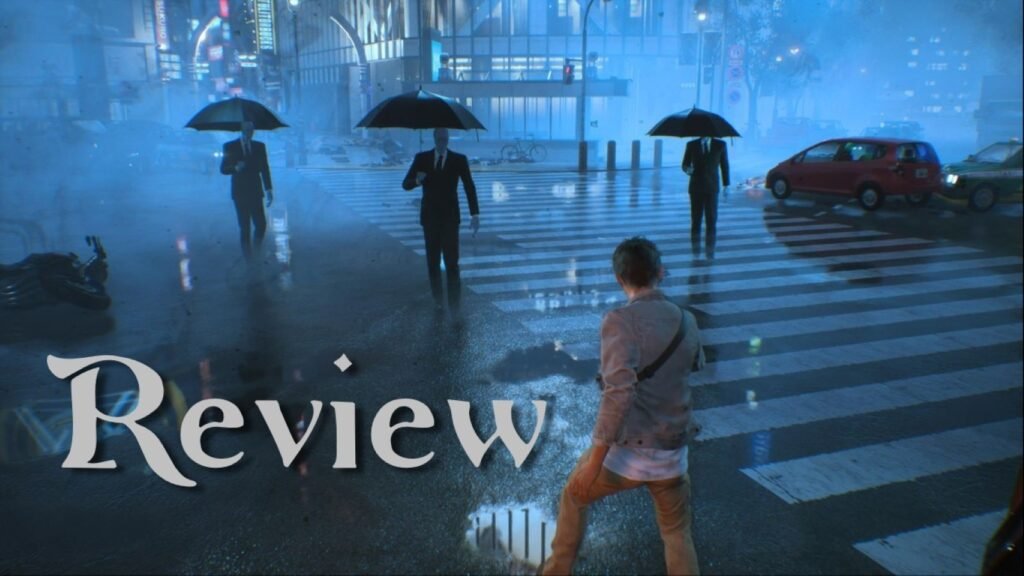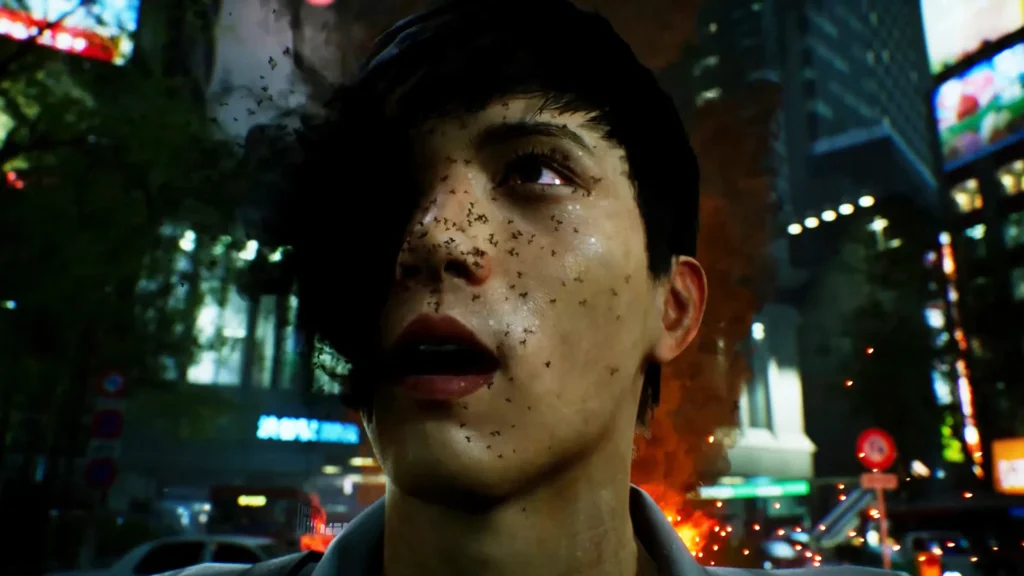
Tokyo’s Shibuya district is one of the liveliest places on the planet. Day or night, it’s teeming with people and brimming with energy. Ghostwire: Tokyo offers a radically different perspective on this iconic urban hub—one where a supernatural force has left the streets eerily deserted. It’s a nightmarish vision, but still an incredible recreation of the city. Is this really Shibuya? It feels astonishingly authentic, though with more prominent shrines scattered throughout. This dedication to the setting is complemented by a strong commitment to Japanese folklore and tradition. Unfortunately, the game is let down by bland mission design and one-dimensional combat, making it more enjoyable as a virtual tourist than as a game.
Ghostwire features two protagonists. Akito is the lone corporeal survivor of the mysterious fog that turned Shibuya into a literal ghost town. He was already in a bad place before the spirits appeared, with his sister in a nearby hospital, and he’s desperate to find out what has become of her. However, he finds himself in an uneasy alliance with Keikei, a surly spirit bent on settling a score with the hanyu-mask-wearing madman responsible for the attack.
This uneasy partnership means they literally fight for control over the same body. Their initial clashes eventually give way to a shared goal and a growing understanding. While I didn’t find either character especially relatable, their family-focused backstories helped ground the otherwise grandiose main plot. Plus, with Keikei by his side, Akito gains supernatural powers, which come in handy when dealing with the unsettling spirits that haunt the streets.
Though Ghostwire is set in an open world, it doesn’t start that way. The map is initially shrouded in fog, which must be cleared, torii gate by torii gate. This isn’t necessarily a bad thing, as the urban environment is incredibly dense. Progressing through the fog and purifying each gate gives you the chance to explore and appreciate different facets of the city. After all, Tokyo is a city of contrasts: a place that balances the glitz of modernity with the quiet reflection of tradition, the intensity of its concrete jungle with pockets of greenery offering an escape, and the bustling tourist hotspots with forgotten backstreets. Ghostwire captures these contrasts beautifully with an impressively detailed world design, making the city feel incredibly real—even if it’s trapped in a perpetual night. Regular downpours add to the eerie atmosphere, with piles of abandoned clothes, trapped spirits, and strange creatures lurking around every corner.
The city is also packed with collectibles. There are spirits to save and send to safety via modified phone booths scattered throughout, jizo statues that upgrade your elemental ammo capacity, unique items you can trade for rewards, and even a tanuki hunt. You’ll also find sources of cash, consumables, skill points, and ether, which fuels your attacks. There’s a lot to take in, but thankfully, spectral vision helps by emitting a pulse that highlights anything of interest nearby, so you don’t have to search pixel by pixel. The many yokai in the city, such as cats you can buy from or tengu that help you reach rooftops, are marked on the map once discovered.

While Ghostwire’s connection to Japanese culture and mythology is one of its major appeals, at times these elements feel more like a crutch. The yokai hunts, for example, rely on the “otherness” of these creatures and a bit of cultural insight to make up for their lack of challenge. Sure, one enemy might be an anthropomorphic umbrella, but there’s not much depth or engagement beyond that. Similarly, it’s the Japanese context that gives many sidequests their charm. A visit to a neighborhood sento bathhouse, with a mural of Mount Fuji on the wall, seamlessly transitions into a combat area. Or a park full of dead cherry trees that you restore to radiant pink blossoms.
On the flip side, sidequests that don’t have such thematic hooks often feel like filler. For example, finding toilet paper for a specter stuck on the toilet? It’s a quirky and somewhat amusing task, but it’s hard to take it seriously when the larger plot revolves around a madman planning to consume thousands of souls in a dark ritual. It’s moments like these that highlight the disconnect between the game’s epic narrative and its trivial side activities.
The NPCs are also a challenge. They’re ethereal spirits with comically pitch-shifted voices, minimal animation, and no discernible facial expressions. Conversations with them rarely feel meaningful or engaging, making it hard to invest in their stories. For instance, one specter asks you to help find their mommy, but it all comes off as more of a mechanical task than an emotional moment. This issue is compounded by the repetitive nature of many quests, which only serve to emphasize the lack of depth in the side content.
When it comes to gameplay, combat is where Ghostwire shines most. Its system of elemental attacks provides a fresh take on first-person ranged combat. The hand gestures and the way you expose and rip out an enemy’s core feel incredibly satisfying. I also love the thematic choice to have everyday office workers and schoolchildren in uniforms as the game’s basic enemies. It’s unsettling to fight these familiar, almost mundane figures, even if some of the later foes are more visually striking.
Overall, Ghostwire: Tokyo offers a unique blend of supernatural horror and Japanese folklore, set against a hauntingly beautiful recreation of Shibuya. While its atmosphere, setting, and combat system offer much to enjoy, the lack of depth in its missions and sidequests, along with the repetitive NPC interactions, prevent it from living up to its full potential as a compelling game. It’s an experience best suited for players who enjoy exploring Tokyo’s streets from a supernatural perspective, but less so for those seeking a deeply engaging, well-rounded narrative.
Wind, water, and fire attacks form the core of your arsenal in Ghostwire: Tokyo, but you also have several other options at your disposal, including stealth kills, talismans that can stun or distract enemies, a basic strike attack for close combat, a bow for long-range engagements, and the ability to block or parry attacks to minimize damage.
Despite these diverse tools, I found myself relying on just two basic tactics for most of the game because they were so effective that I rarely needed anything else. The first was to quickly purge everything in sight. The “Visitors” (the game’s basic enemies) are incredibly simple to deal with, and sneaking up on them is often laughably easy. With spectral vision, you can stay hidden and wait for the perfect moment to strike. Initially, taking out enemy after enemy this way is satisfying, especially with the fantastic purge animations and sound effects. However, it becomes repetitive and one-dimensional, as the strategy doesn’t need to evolve even when new enemies or variants are introduced.
Most of the overworld enemies can be instant-killed, and once I realized just how powerful stealth was, I invested heavily in it, making it even more efficient. When stealth wasn’t an option, or if I was detected, my other go-to solution was the “BFG.” No, not that BFG—the big fireball grenade. This became my answer to nearly every combat situation. Thanks to the simple AI, I could just back up while charging the grenade, and the enemies would line up perfectly for me to clear them all at once.
Like stealth kills, this tactic—creating space and then unleashing your biggest attack—worked in nearly every encounter, regardless of enemy types. It made the combat feel very one-dimensional and formulaic, offering little room for variety. For a game that plays with psychological tension and mind-bending twists during the story missions, it’s disappointing that this sense of unpredictability doesn’t extend to the regular combat encounters in the open world. The absence of this atmospheric depth in the moment-to-moment gameplay stands in stark contrast to the richer narrative sections.
As for the main story itself, at its core, Ghostwire is about the evolving relationship between Akito and KK, and their quest for peace with their pasts. Family is a central theme for both the heroes and the villains, and while I appreciate this aspect, the resolution of Akito’s personal struggle left me a bit unsatisfied. The emotional payoff didn’t feel as impactful as it could have been. Similarly, the villain’s messianic zeal and grandiose plan make him come across as little more than a cartoonish antagonist. His over-the-top theatrics reduce him to just another obstacle to overcome, rather than a truly memorable or compelling character.
I still enjoyed my roughly 20 hours with Ghostwire: Tokyo, mostly because I found its world so immersive. The level of detail in the city is impressive, whether it’s recreating the iconic Shibuya Crossing or bringing life to a dark, dank alleyway. This is a world I loved being in, especially because of the many references to Japanese culture and mythology.
If the moment-to-moment gameplay—particularly the combat and mission design—had been more engaging, Ghostwire could have been a truly captivating experience. As it stands, the combat and mission structure are merely adequate. They don’t detract from the brilliance of the setting, but they certainly don’t elevate it either.